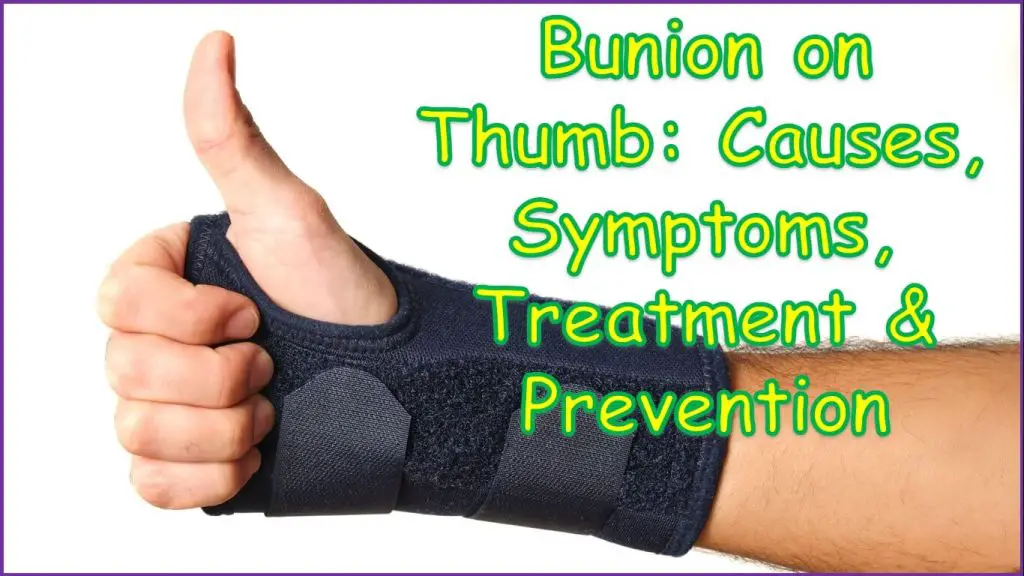Do you experience a sore bump on your thumb? It’s plausible that you have a bunion on your thumb. While bunions are commonly associated with the big toe, they can also form on the thumb. This article will explore the reasons behind the formation of bunions on the thumb, the symptoms they cause, their treatment options, and preventive measures.
What Is A Bunion On Thumb?
A bunion on the thumb, also known as “brachymetatarsia,” is a bone protrusion that arises on the metacarpophalangeal (MCP) joint of the thumb. This joint can be found at the thumb’s base, where it joins the wrist. The bunion can cause pain and impede hand function.
Causes Of Bunion On Thumb
There are various reasons why bunions can form on the thumb, including:
- Genetics: Bunions are hereditary, so if someone in your family has one, you may be more prone to developing one as well.
- Injury: The thumb can suffer trauma, leading to bunion formation.
- Arthritis: Osteoarthritis or rheumatoid arthritis can cause bunions to form on the thumb.
- Overuse: Repetitive use of the thumb, such as prolonged use of a computer mouse, can contribute to bunion formation.
Symptoms Of Bunion On Thumb
Bunion on the thumb’s most prevalent symptoms include:
- Pain and swelling around the MCP joint of the thumb.
- Difficulty gripping or holding objects.
- A visible bump at the base of the thumb.
- Redness and inflammation around the affected area.
Treatment For Bunion On Thumb
The treatment plan for a bunion on the thumb depends on the condition’s severity. Mild cases can often be resolved with non-surgical approaches, while more severe cases may necessitate surgery. Treatment options include:
- Changing footwear: To minimize bunion pressure, wear shoes with a broad toe box.
- Splinting: A splint may be used to keep the thumb in a straight position, reducing pressure on the bunion.
- Medications: Non-steroidal anti-inflammatory drugs (NSAIDs) can help reduce pain and swelling.
- Physical therapy: Stretching and strengthening exercises can help alleviate pain and enhance hand function.
- Surgery: In extreme cases, surgery may be needed to remove the bunion.
Prevention Of Bunion On Thumb
While some causes of thumb bunions, such as genetics and arthritis, cannot be avoided, several measures can be taken to reduce the risk of developing one, such as:
- Wearing appropriate footwear: Choose shoes with a broad toe box and avoid high heels.
- Stretching: Regular hand and finger stretching can prevent stiffness and reduce the risk of bunion formation.
- Taking breaks: If you use your hands frequently, take regular breaks to rest and stretch them.
- Using proper technique: Using proper typing or computer mouse technique reduces the risk of bunion formation.
- Maintaining a healthy weight: Being overweight can increase the pressure on your feet and hands, which can lead to the formation of bunions.
FAQs About Bunion On Thumb
Q: Can bunions on the thumb be prevented?
A: While some causes of thumb bunions cannot be avoided, taking certain steps can minimize the risk of developing them.
Q: What is the most common cause of thumb bunions?
A: Genetics is a common cause of thumb bunions. If someone in your family has one, you may be more prone to developing one as well.
Q: How is a bunion on the thumb diagnosed?
A: A physical exam and imaging tests, such as X-rays, physical therapy, while surgery may be necessary for severe cases. To prevent bunions on the thumb, it’s important to wear proper footwear, stretch regularly, take breaks if you use your hands frequently, use proper technique when typing, and maintain a healthy weight.
If you’re experiencing pain or swelling around the MCP joint of your thumb or have a visible bump at the base of your thumb, it’s possible that you have a bunion on your thumb. It’s important to see a doctor for a proper diagnosis and to discuss treatment options that are best suited for your specific condition.
In conclusion, while bunions on the thumb may not be as well-known as bunions on the big toe, they can still be a painful and debilitating condition. With the right treatment and preventative measures, however, you can reduce your risk of developing a bunion on your thumb and keep your hands healthy and functional.
Thank you for reading our article on bunions of the thumb. We hope you found it informative and helpful. If you have any questions or comments, please feel free to leave them below. Your feedback is valuable to us and helps us improve our content. Don’t forget to share this article with anyone you think might benefit from it. Together, we can spread awareness and promote better foot health for everyone.
See Also:
- Avoiding Problems After Bunion Surgery
- How Painful is Bunion Surgery?
- Do Flip Flops Cause Bunions? Are Flip Flops Bad for Bunions?
- Best Cute Sandals That Hide Bunions
- Best Shoe After Calcaneal Fracture
- Best Pain Relief Pads for Bunions
- What Are The Different Types of Bunion Surgery
- Lapiplasty Bunion Surgery Pros and Cons
- Bunion Surgery Recovery Time [Week By Week]
- What To Expect 3 Weeks After Bunion Surgery
- Do men get bunions
